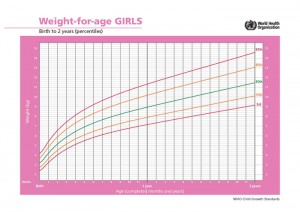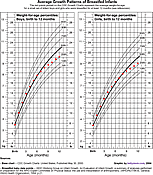- Growth charts and breastfed baby growth
- A note about growth charts
- Growth chart comparisons
- Additional information and references
 Growth charts and breastfed baby growth
Growth charts and breastfed baby growth
I have heard of many breastfed babies (including my own) whose doctor was disturbed at some point because the baby wasn’t gaining weight quickly enough, even though the baby was well within the parameters for weight gain of breastfed babies. The problem is that many doctors are not familiar with the normal weight gain patterns of breastfed babies, and rely too much upon older growth charts that are based upon the growth of artificially fed babies. In 2006, the World Health Organization released revised growth charts that are representative of healthy breastfed babies throughout the world. Until doctors are familiar with them, we need to keep ourselves informed so that doctors don’t undermine our confidence to breastfeed our babies.
Healthy breastfed infants tend to grow more rapidly than their formula-fed peers in the first 2-3 months of life and less rapidly from 3 to 12 months. All growth charts available before 2006 (which are still used by many health care providers in the US) included data from infants who were not exclusively breastfed for the first 6 months (includes formula-fed infants and those starting solids before the recommended 6 months). Because many doctors are not aware of this difference in growth, they see the baby dropping in percentiles on the growth chart and often come to the faulty conclusion that the baby is not growing adequately. At this point they often recommend that the mother (unnecessarily) supplement with formula or solids, and sometimes recommend that they stop breastfeeding altogether. Even if mom realizes that her baby is perfectly healthy and doesn’t follow these unnecessary recommendations, she ends up worrying for no reason (and moms don’t need anything extra to worry about!).
Now infants can get
all their vitamin D
from their mothers’ milk;
no drops needed with
our sponsor's
TheraNatal Lactation Complete
by THERALOGIX. Use PRC code “KELLY” for a special discount!
In February 2012, the American Academy of Pediatrics, in their policy statement Breastfeeding and the Use of Human Milk, stated that “Infant growth should be monitored with the World Health Organization (WHO) Growth Curve Standards to avoid mislabeling infants as underweight or failing to thrive.” The US Centers for Disease Control also recommend that the WHO growth charts be used for children age 0-2.
Even if a doctor is informed of the difference in growth patterns, she might not be willing to listen…
“When I told my daughter’s pediatrician that I had read that breastfed babies gain weight slower than indicated by the growth charts, and asked what her thoughts were, she said that she didn’t believe that it was true and continued to question my daughter’s weight. She refused to take a look at the article from Pediatrics [see reference below] that I brought to her office. I was rather surprised at this, since she had breastfed her own children. I ended up changing doctors, and my new doctor had no problem whatsoever with my daughter’s rate of weight gain.”
A note about growth charts
A growth chart isn’t a test, where you are striving to get your baby into the 100th percentile. The growth charts show us the statistical distribution of weight, height , etc. in a particular set of babies (or children or adults). So if a baby is in the 50th percentile for weight on the CDC charts, it means that half of the healthy babies of the same age in the US are heavier and half are lighter; if a baby is in the 10th percentile for height, then 90% of babies of the same age in the US are taller and 10% are shorter. Healthy babies, just like adults, can come in all shapes and sizes – a baby in the 3rd percentile can be just as healthy and normal as a baby in the 97th percentile. What doctors are generally looking for on a growth chart is that baby stay relatively consistent in their growth pattern (see above for why this may not happen with earlier growth charts). Growth charts are only one part of the puzzle, however, and must be evaluated along with other factors, including:
- What size are baby’s parents? What were their growth patterns as babies? What about baby’s siblings or other family members? Genetics plays a large part in baby’s size, so don’t ignore it.
- Is baby gaining consistently, even if it’s not on a curve?
- Is baby meeting developmental milestones on or near target?
- Is baby alert, happy, active?
- Is baby showing other signs of adequate milk intake?
Growth Chart Comparisons
 [click for large version] |
| Average Growth Patterns of Breastfed Infants The points plotted on the 2000 CDC Growth Charts represent preliminary WHO data from the average weight-for-age for a small set of infant boys and girls who were breastfed for at least 12 months. Note how the growth of the healthy breastfed babies (plotted in red) appears to falter on the CDC growth charts. I’m in the process of updating this graphic to show data from the finalized WHO charts. |
2000 US CDC Growth Charts:The US Centers for Disease Control revised their standard growth charts in 2000, based upon more recent data which are “representative of the United States population, reflecting the Nation’s cultural and racial diversity.” Per the CDC Growth Chart FAQ: The 2000 CDC Growth Chart reference population includes data for both formula-fed and breast-fed infants, proportional to the distribution of breast- and formula-fed infants in the population. During the past two decades, approximately one-half of all infants in the United States received some breast milk and approximately one-third were breast-fed for 3 months or more. A Working Group of the World Health Organization is collecting data at seven international study centers to develop a new set of international growth charts for infants and preschoolers through age 5 years. These charts will be based on the growth of exclusively or predominantly breast-fed children. |
1977 Growth Charts:The 1977 growth charts for babies under 2 years old were based on a study conducted in Ohio from 1929 to 1975. The babies in this study:
As a result, the 1977 growth charts are not a reliable indicator of the growth of children who:
|
How well do the 2000 CDC Growth Charts estimate growth of breastfed babies?
de Onis and Onyango (2003) used weight and length measurements from a sample of 226 healthy breastfed infants to evaluate the new 2000 CDC Growth Charts and the National Center for Health Statistics/World Health Organization (NCHS/WHO) growth reference. They found that there were “notable differences in the growth trajectory of breastfed infants” and concluded that “A reference based on healthy breastfed infants is required if the growth patterns of infants following international feeding recommendations are to be correctly assessed.” Click to see a chart illustrating this difference.
References
American Academy of Pediatrics Section on Breastfeeding. Breastfeeding and the use of human milk. Pediatrics. 2012 Mar;129(3):e827-41. Epub 2012 Feb 27.
The WHO Child Growth Standards: Geneva, Switzerland, Published April 27, 2006.
CDC Growth Charts: United States, Published May 30, 2000.
WHO Working Group on Infant Growth. An Evaluation of Infant Growth: a summary of analyses performed in preparation for the WHO Expert Committee on Physical Status: the use and interpretation of anthropometry. (WHO/NUT/94.8). Geneva: World Health Organization, 1994.
Additional information on growth charts
Average Weight Gain for Breastfed Babies
Growth Charts Training Modules on accurately weighing and measuring infants & children from the US Maternal and Child Health Bureau
CDC Growth Chart Training Modules
WHO growth charts
The WHO Child Growth Standards: Geneva, Switzerland, Published April 27, 2006.
Iota Charts is a free web-based service for tracking your baby’s growth on the WHO growth charts.
Standard growth charts
CDC Clinical Growth Charts. Weight for age and length for age charts are much less important than the weight for length (growth velocity). If your baby is staying relatively consistent on the weight per length chart, then he/she is likely to be growing perfectly fine.
Child Growth Charts of height weight and body mass index from halls.md. The growth charts available on this web page are derived from NHANES III data (a comprehensive survey of the American population during years 1988-1994). This data was re-analyzed and re-plotted for the halls.md growth charts.
Growth charts and breastfed babies
Growth Patterns of Exclusively Breast-Fed Infants discusses and charts differences in the CDC Growth charts and growth of exclusively breastfed babies (may require free Medscape registration)
Why the CDC recommends use of WHO growth charts in the U.S. for children up to 2 years old
de Onis M, Garza C, Victora CG, Bhan MK, Norum KR, ed. The WHO Multicentre Growth Reference Study (MGRS): Rationale, planning, and implementation.
de Onis M, Onyango AW. The Centers for Disease Control and Prevention 2000 growth charts and the growth of breastfed infants. Acta Paediatr. 2003 Apr;92(4):413-9.
Conclusion: As was the case when compared with the NCHS/WHO reference, there are notable differences in the growth trajectory of breastfed infants examined against the CDC reference. A reference based on healthy breastfed infants is required if the growth patterns of infants following international feeding recommendations are to be correctly assessed.
DeOnis M, Garza C, and Habicht J-P. Time for a new growth reference. Pediatrics. 1997: 100(5) e8.
